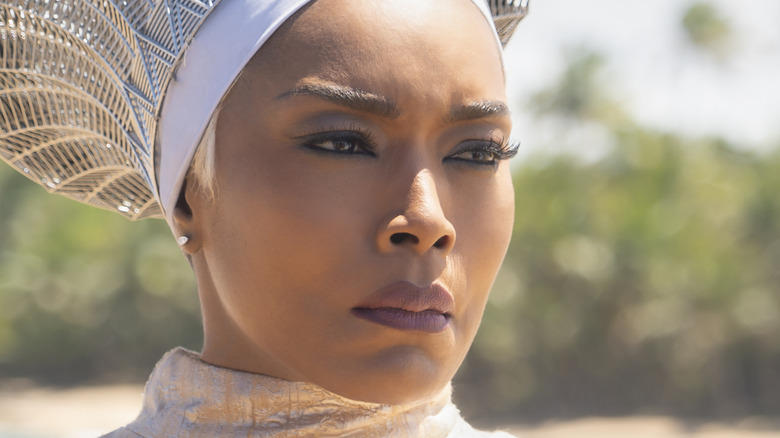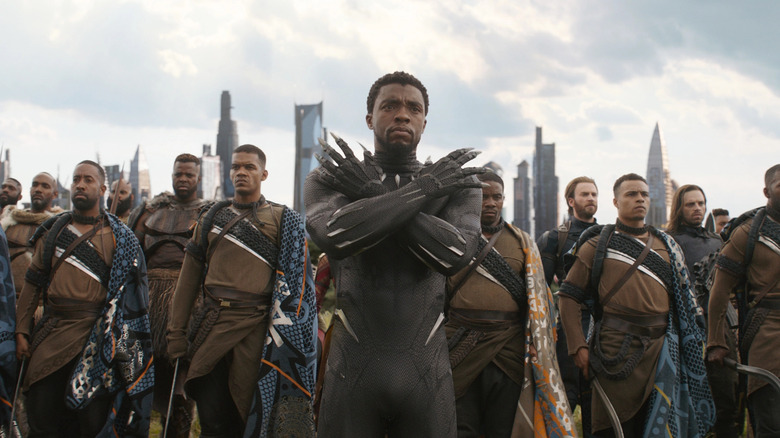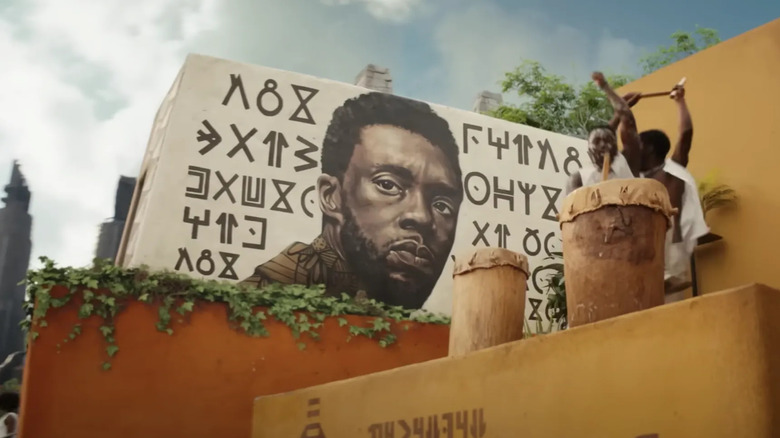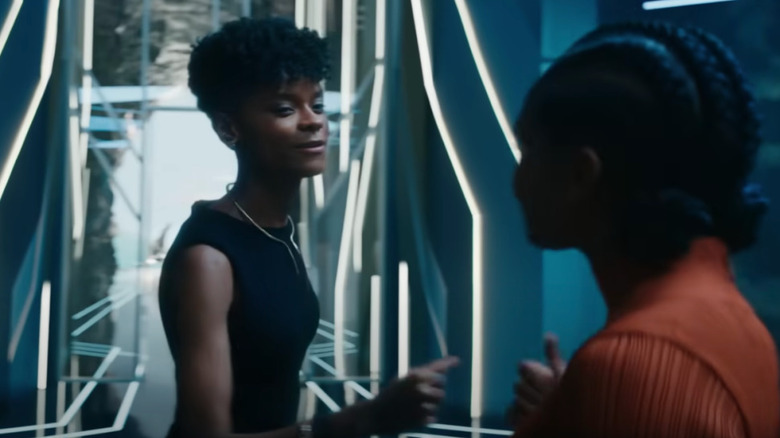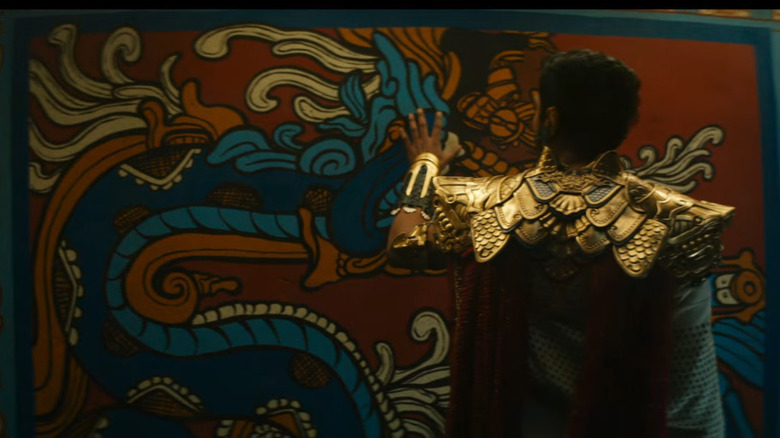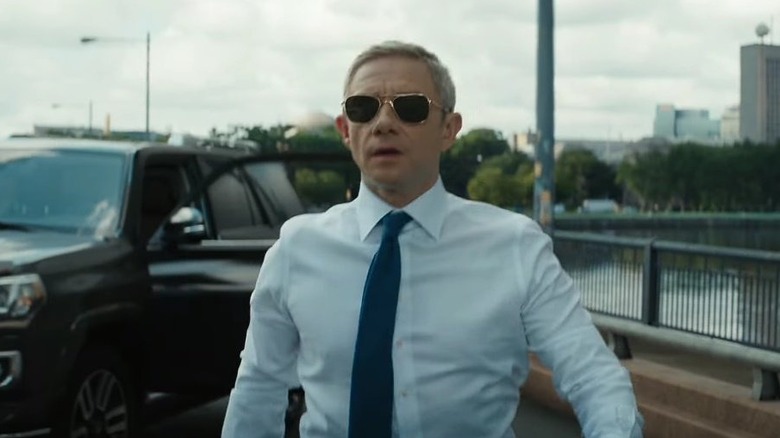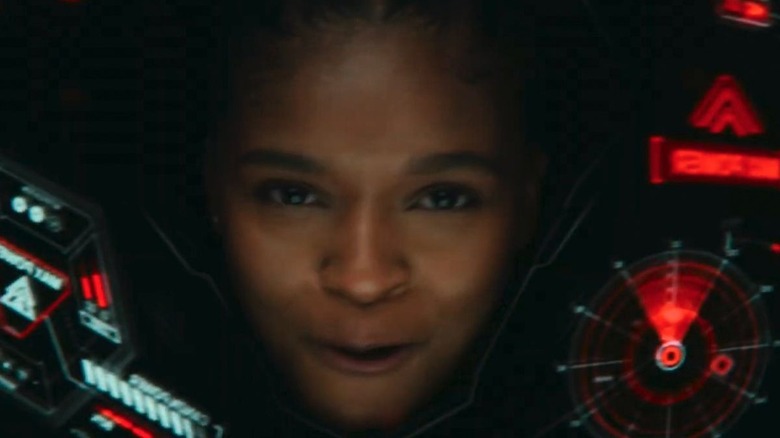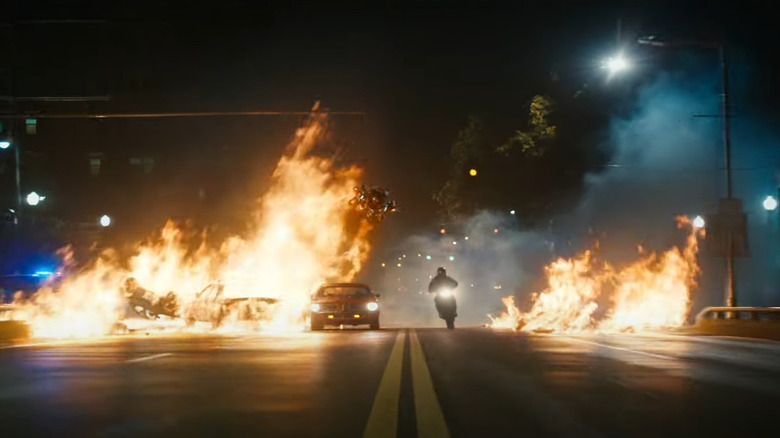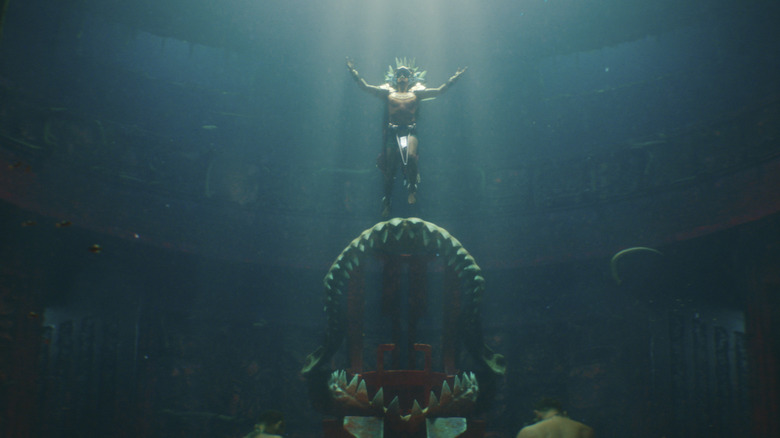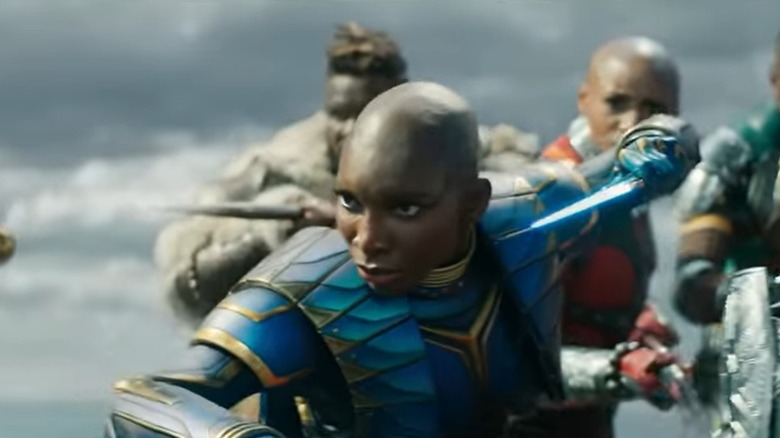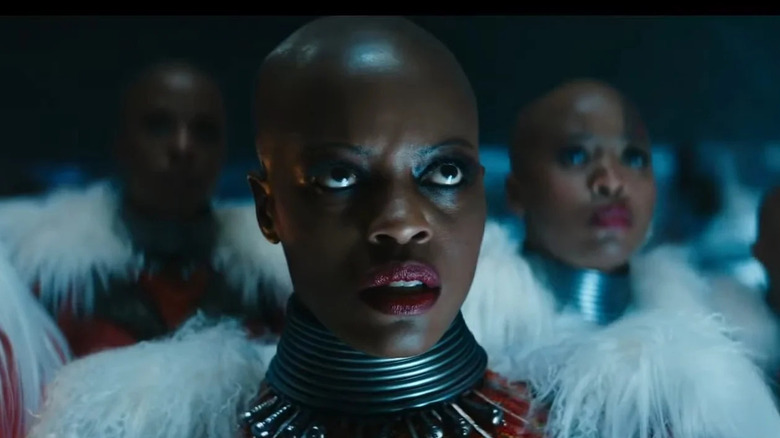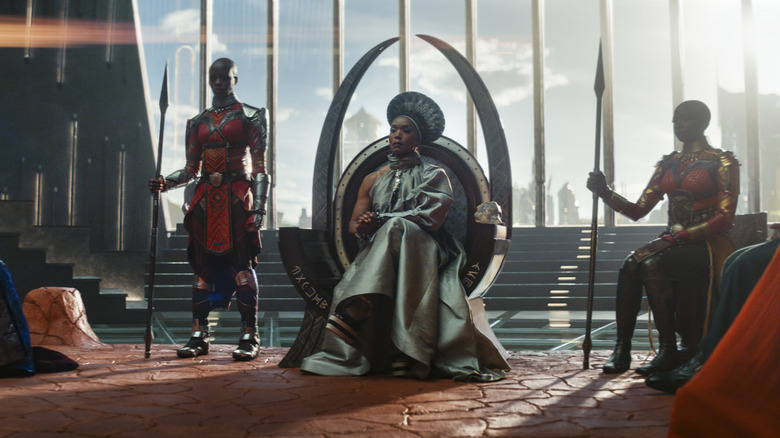Easter Eggs You Missed In Black Panther: Wakanda Forever
"Black Panther: Wakanda Forever" had an incredibly difficult job to do.... several of them, actually. As the last film of Marvel's Phase Four, it had to tie up the post-blip era of the Marvel Cinematic Universe and transition the franchise into future overarching plot lines. As the direct sequel to Marvel's second-highest-grossing solo character movie and their only film to be nominated for best picture at the Academy Awards, it had to live up to the high expectations set by its predecessor. And most of all, it had to honor the loss of its beloved star, Chadwick Boseman, who filmmakers elected not to replace.
"Wakanda Forever" rises to meet its many challenges. Ryan Coogler's second installment in the "Black Panther" franchise is a carefully considered and reverent yet fast-paced and action-packed nearly three-hour-long film that blends Marvel's aesthetic, real-world mythology, and meaningful tributes to its late leading man. "Wakanda Forever" sets up the MCU to come in some unexpected ways. The tone and purpose of the 30th film in this now multi-decade-long project mean there aren't as many tongue-in-cheek jokes or knowing winks to the camera. It's too serious and important to even bother with an end-credits stinger. But there are still fun Easter eggs, callbacks to the original "Black Panther," and references to many of "Wakanda Forever's" inspirations. These are some you might have missed:
The opening credits pay respect to Chadwick Boseman
"Black Panther: Wakanda Forever" opens with a scene that's sure to well tears in the audience's eyes. Shuri is frantically working on printing a synthetic version of the heart-shaped herb that gives the Black Panther their powers and allows Wakandans to access the ancestral plane. But her research has only gotten her so far when her sick brother's heart rate begins to fall. Its probability of success is hovering around 30% when Queen Ramonda enters the lab to tell her T'Challa is gone.
The scene crossfades from Shuri's devastated face to what seems like the standard Marvel Studios opening credits. For the most part, this is the graphic format that Marvel fans around the world have come to know and love. But this time, instead of the familiar triumphant Marvel Studios theme music, there's absolutely no music or sound at all. And instead of a highlight reel of all of the MCU's mightiest and most popular heroes, as per usual, every letter is filled with stills and clips of Chadwick Boseman as T'Challa from all four of his appearances. When the Marvel Studios logo arranges itself in place, the words first glow with the purple of the heart-shaped herb before fading into the black and silver of T'Challa's Black Panther suit.
This slight change to the opening credits format pays respect to Chadwick Boseman and leads beautifully into the funeral scene that immediately follows.
T'Challa's death mirrors that of the actor who played him
When it was announced that "Wakanda Forever" would not be recasting the role of Black Panther aka King T'Challa, fans began to speculate about how the sequel would deal with Boseman's tragic death. Trailers made it clear that T'Challa dies in the world of the MCU, but the how was kept secret. It turns out, T'Challa passed in much the same way Boseman himself passed: from an illness he kept from the public and shared only with his closest loved ones. There's a mural in the film's funeral scene with Wakandan letters that translate to, "The Panther King Forever Live in Us and Rest." Disney also honored Boseman with a mural. This similarity — how they died and how the world reacted – is entirely too somber to call an Easter egg, but it's still significant and worth discussing.
That T'Challa's death mirrors Boseman's death makes the first part of "Wakanda Forever" even more impactful. It also allows Ryan Coogler and the cast and crew to avoid trivializing Boseman's fatal illness by substituting his real tragedy for a possibly cheap-feeling narrativized one. Boseman's family and creative partners, including his widow Simone, were consultants on the film, so the story of T'Challa's death was handled with their seal of approval. That filmmakers chose not to overly fictionalize the end of T'Challa's story helped "Wakanda Forever" to clear what was, without a doubt, its highest hurdle.
Shuri's symbolic tattoo
One of the recurring themes that run throughout "Wakanda Forever" (and there are several) is the conflict between, on one hand, science and technology, and on the other, belief and tradition. Shuri is squarely on team science and technology, and she wears them quite literally on her hand. Viewers don't have to look that closely to catch the Princess's new tattoo; it's prominently displayed several times throughout the movie. There's a graphic design that resembles rearranging particles. Perhaps it's a visual representation of the chemical makeup of Vibranium or some other scientific breakthrough she's been working toward?
Shuri rejects the idea of the supernatural throughout "Wakanda Forever" even after she experiences it via the ancestral plane for herself. She tells her mother that T'Challa didn't touch her shoulder. That was just a figment of her imagination. She gives up on the heart-shaped herb in favor of better weapons and suits. Shuri and M'Baku even reference his accusation in the first "Black Panther" that Wakanda's technological advancements have been overseen by a "child who scoffs at tradition." Many other characters' body modifications harken back to their heritage. That Shuri puts her faith so totally in science and in her own genius is a huge part of her identity, and her tattoo is a shorthand representation of that. So is the fact that her own Black Panther ceremony uses the synthetic heart-shaped herb and takes place without pomp or circumstance (or incense) on an examination table in a cold laboratory room.
Homages to the gods
Though Shuri is mostly concerned with AI and 3D printing, much of the rest of "Wakanda Forever" is concerned with the historical and the spiritual, especially when it comes to the film's version of Namor and his homeworld. Gods are everywhere. Bast, the MCU's Panther god loosely based on Egypt's Bastet, is the primary deity in Wakanda and is mentioned multiple times. The Wakandans wear face paint that looks vaguely panther-like at T'Challa's funeral. Two panther statues can be seen outside of a structure, and a large panther carving rests outside one of the country's underground research facilities.
M'Baku and the Jabari, however, worship Hanuman, a gorilla spirit loosely based on a Hindu god of the same name. That's why M'Baku wears a gorilla mask when he challenges T'Challa in "Black Panther" and its why his hand print face paint looks different from the Wakandans at T'Challa's funeral. There are also enormous gorilla statues throughout Jabariland, including one in M'Baku's throne room.
Mesoamerican iconography is even more prominent throughout "Wakanda Forever." The room in which Namor first speaks with Shuri is covered in murals of Aztec and Mayan gods, including K'uk'ulkan, which is both one of Namor's aliases and a mythical creature that the Yucatec Mayan people (mentioned in the film) really worshipped. M'Baku points out that Namor's people might consider him a god, based on his nickname. His scant costume is also adorned with mesoamerican pictograms.
The colonizer's back
It's not entirely a surprise that Everett Ross is in "Wakanda Forever." After all, he had a fairly large role in the original. Shuri used Wakandan technology to save his life after he was shot, and with T'Challa's little sister and Wakanda's top mind promoted to the protagonist, we were likely to see him again. How he's used is thoroughly unexpected. "Wakanda Forever" serves as a preamble for the upcoming "Thunderbolts" movie, thanks to a subplot involving his former marriage to Julia Louis-Dreyfus's Valentina Allegra de Fontaine.
But for now, the MCU is more concerned with his relationship with Shuri, to whom he owes an enormous debt. Upon their first meeting, Shuri called him a "colonizer." She used it as both a bit of cultural criticism and a cheeky term of endearment. When she sees Everett Ross again, she greets him with the same pet name and decides to exchange his debt with her for information about Riri Williams, who designed the Vibranium detector.
In "Black Panther," Everett becomes fascinated by the remote Kimoyo beads that the Wakandans use to stabilize injuries (including his own) and to communicate. Here, he finds a bracelet of them at the crash site, which Valentina bugs. When he isn't willing to help stage an offensive against Wakanda, he's presumably taken into custody. Later, Okoye and Shuri track Everett down and free him. Okoye quips now that she's seen a colonizer in chains, she's seen everything. Since Western oppression of indigenous people is a running theme in "Wakanda Forever," this callback works on two levels.
Riri's backstory
In addition to teeing up "Thunderbolts" plus introducing a new Black Panther (or two) and a new anti-hero in Namor, "Wakanda Forever" also features the MCU debut of Riri Williams, also known as Ironheart. The character is getting her own Disney+ series soon, and fans knew from the trailer that she'd be a part of "Wakanda Forever," though the film doesn't use her superhero name yet. Riri's introduction is refreshingly light on backstory. Most of what we know about her comes via visual clues and cryptic dialogue as opposed to a less elegant exposition dump.
In the comics, Riri Williams is usually a 13- to 15-year-old super genius who hails from Chicago. Some fans thought "Wakanda Forever" might venture to the windy city for Riri, but she's already a student at MIT when Okoye and Shuri go looking for her. She has a Chicago Bulls pillow on her bed (and curiously, phases of the moon wall hanging, which might be a reference to Moon Knight or might just be the type of decoration college kids put in dorms). Riri also mentions that both her father and her stepdad have died; this is the case in the comics as well. In the source material, Riri constructs her first suit mostly from stolen parts. We see her bartering with another student for parts in the film, and when Shuri deconstructs her Vibranium detector, she deduces that it's assembled from scrap. If you look closely, her stud earrings are tiny iron hearts. Her in-helmet shots call back to Tony Stark as does her mission to fly dangerously high to stop the drone.
Pay attention to that license plate
Riri's car holds sentimental value, which is why it's such a grand gesture when Shuri recovers its pieces and has it restored to practically brand new in the film's final act. The chase scene involving the hot rod as well as a motorcycle and Riri's first Ironheart suit is one of the most exhilarating sequences in "Wakanda Forever," but there's more to it than meets the eye. For one thing, Riri's gearheadedness is apparent in the design of her super suit, both in her amateurish version and in the one Shuri crafts for her during their showdown with the people from Talokan. The shoulder armor, for example, is either reminiscent of or actually made from car parts.
The most Easter egg-like thing about Riri's car, however, is its license plate. It reads EE-0710. We can guess that "EE" stands for Easter egg. The meaning of 0710 is less obvious. The simplest answer to this riddle is that it's a nod to 2018's "Black Panther" Vol. 7 #10, the story of which touches on the multiverse, mutants, and Egyptian gods. The issue is probably a true Easter egg as the "EE" suggests, meaning it might not necessarily signal specific plot points to come. But, between the MCU's many multiversal projects, Disney's acquisition of Fox and the slow rollout of mutants and X-Men characters, and "Moon Knight" as well as an increased interest in gods ("Eternals" as well as Zeus and Hercules in "Thor: Love and Thunder"), it's a general match for the direction the franchise is headed in.
Atlantis becomes Talokan
In Marvel comics, Namor rules over Atlantis. But since the DCEU got to the legendary lost and submerged civilization first with "Aquaman," Marvel Studios had to come up with a workaround. Their solution is an elegant and thematically charged improvement on the existing canon. Filmmakers took Namor McKenzie, a half-human half-Atlantian weirdo whose name is "Roman" spelled backward (as opposed to "no amor" or "no love") and, via a well-researched infusion of mesoamerican mythology, turned him into 14th-century god. In doing so, they've effectively transformed the story of Namor into commentary on Spanish conquistadors' pillaging of Central and South America.
Atlantis becomes Talokan, which is a simplified spelling of Tlālōcān, an Aztec dream world. In mythology, it's the realm of Tlālōc the rain god. He gets a shout-out in the film. It's this entity that Namor's people pray to when they concoct their own version of the heart-shaped herb potion with their own Vibranium-laced plants. In Wakanda, only the monarch ingests the magic elixir. In the Yucatan, everyone does. Namor's mother is hesitant since she's pregnant, and the mystical substance gives her son strange mutations like winged feet, pointed ears, long life, and the ability to get oxygen from air or water. Everyone else turns blue and must resort to life in the ocean. Namor's mutations earn him the status of the god K'uk'ulkan, which means feathered serpent god since he can inhabit the air, land, and sea. It's notable that in the film, a second Vibranium meteorite hits the Yucatan. The meteor that's theorized to have led to the extinction of the dinosaurs struck there about 65 million years ago.
The Midnight Angels
There's a running joke throughout "Wakanda Forever" that Okoye isn't too impressed with the latest enhanced ensemble that Shuri's been designing for her. The new armor is much bluer and covers much more of the body than what Okoye and the Dora Milaje are used to wearing. But Shuri insists that the outfit comes with added benefits that will make it worth her while. Okoye (along with Aneka) dons the armor only after Queen Ramonda forces her to resign and she has surrendered her weapon because Shuri promises her it comes with a brand new spear.
These odd-looking uniforms with their buggy eyes and tentacle-like appendages are actually comic book accurate, both in their appearance and their symbolic use. In Ta-Nehisi Coates and Roxanne Gay's "Black Panther" run, there's an arc in which Aneka, Dora Milaje's combat trainer, kills a chieftain who was mistreating women when it wasn't officially her place to do so. Though Ayo speaks up on her behalf, Queen Ramonda follows the letter of the law and sentences her to death. Several members of the all-female fighting force rescue her and leave the ranks to start their own rebel group, the Midnight Angels. This is the name Shuri gives to the armor in "Wakanda Forever," too.
Ayo and Aneka: partners in love and crime
Speaking of the Dora Milaje, another storyline from the comics pops up (however briefly) in "Wakanda Forever." But to fully understand its implications, we have to go back to a cut scene from "Black Panther." In that film, there was a moment of romantic flirtation between Okoye and Ayo that, for reasons still unknown, was deleted from the final theatrical version. Okoye was written to be married to Daniel Kaluuya's W'Kabi. We get another reference to the events of "Black Panther" when Queen Ramonda removes Okoye from her position and implies that she can still visit W'Kabi in jail, where he is presumably being held for aligning himself with Killmonger.
But near the end of the movie, there's an acknowledgment of a romantic relationship between Ayo — the new head of the Dora Milaje — and Aneka. Their love is canonical. In the Midnight Angels arc, Aneka is the superior member of the Dora Milaje. It's she who recruits Ayo, but is eventually bested by her in training. The two butt heads, but the sexual tension between them is impossible for either to ignore. It's Ayo who breaks Aneka out of prison. The two warrior women dedicate themselves to each other and to the cause of helping those in Wakanda who the powers that be ignored.
The eternal war
Ryan Coogler was adamant that Namor the Sub-Mariner would be the antagonist of "Wakanda Forever." The character is a frequent on-and-off ally and adversary of Black Panther in the comics, and with the change from Atlantis to Talokan, their secret societies have even more in common. Namor confirms in the film that he is, indeed, a mutant. In 2012's "Avengers vs. X-Men," Namor sides with the mutants and floods Wakanda. T'Challa vows a blood oath to kill Namor, which basically locks these two Kings and these two Kingdoms in an everlasting war.
Chadwick Boseman's T'Challa is no longer with us, so he can't be Namor's foil anymore. Shuri takes up that mantle, too. She gets pretty friendly pretty quickly with the Feathered Serpent God and tries to find a diplomatic end to their disagreement. He gifts her his mother's bracelet in return... the very thing that will help her complete the synthetic heart-shaped herb. But Nakia infiltrates Talokan after Shuri had convinced Namor she was an ally, and she fears the mistake has started an eternal war. Tensions escalate when Namor attacks Wakanda and kills Queen Ramonda. Characters, including M'Baku, check her aggression, but Shuri argues that her mother's death is worth the never-ending conflict. "Wakanda Forever" resolves when the new Black Panther has a chance to get revenge and chooses forgiveness and cooperation instead. Basically, the "Black Panther" sequel trades T'Challa for Shuri and runs through the comics' eternal war in about two hours and 40 minutes.
